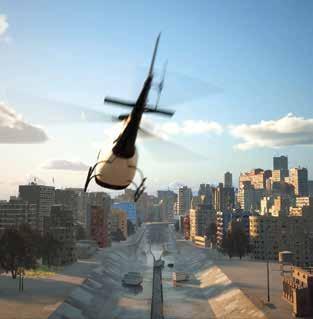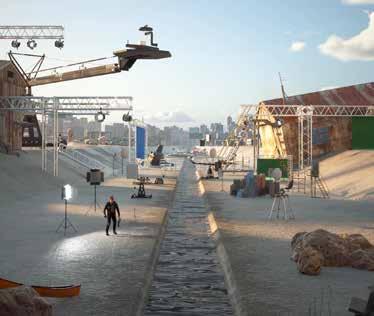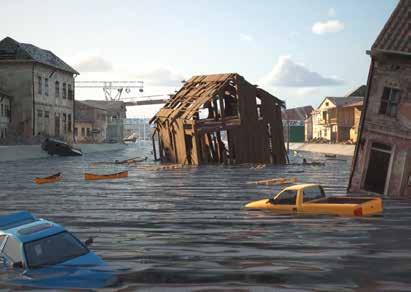
5 minute read
ART AND ARCHITECTURE:

Sophia Akoury’s visual story of heritage and archives
As our world is constantly changing and moving, so are urban landscapes, structures and environments around them. IC Alumna Sophia Akoury of the class of 2015 created a phenomenal thesis project comparing the LA River and Beirut River through a digital media video installation. The project was a combination of using architectural components, historical archiving, and personal touch through an artistic lens. She was recently awarded the Frank Gehry Award at the Southern California Institute of Architecture for this project, which is a high honor for the best thesis project at the school. Sophia tells us the story behind her project, and how connecting the dots in archives and heritage are so important.

Akoury graduated from IC in 2015 as an IB diploma student. After graduating from IC, Akoury studied at ALBA University and graduated in 2019. Afterwards in 2020, she pursued her postgraduate studies at the Southern California Institute of Architecture and graduated this fall of 2022. Akoury has always been interested in architecture from a young age.” Ever since I was a kid, I’d build houses for my dolls. My dad is an architect and I loved seeing his design work”, she says. At the moment, she is working at an architectural firm in LA, and is hoping to become a licensed architect in the near future. Akoury’s plans are to stay in LA and pursue her architectural goals and though she misses home, she’s quite happy that LA reminds her of home. “It reminds me of Beirut! The chaos of it. LA is so Beirut!” she explains.
As a part of her masters graduation requirement, Akoury had the opportunity to pursue a thesis project of her choice. In the beginning, she wanted to create a building in the LA river for her assignment. But as she started the project, she became invested in the story and narrative of the river. “It used to be so many different things across the years. It was a movie location, as one example. I just really wanted to represent all the things it was covering”, she explains. “I thought it was interesting to bring back all of these stories that are connected to the space. I think it’s important to the heritage of the place”, she says.
At the same time, her interest in the LA river peaked from her observation of the Beirut river. “The minute I saw it, it reminded me of the Beirut river. The connection I made is that they were both paved concrete rivers that are inside the city, and that they both look so identical even though they are cities that are so different. They’re both a national river that got paved over”.
With this being her starting point, Akoury made an installation with a moving animation component directing the viewer through the imagery and archives of historical components in the LA river, that eventually transitioned into a scene ending at the Beirut river. As you move through the site, the environment changes. The project was methodically put together, and combined non-traditional architectural drawings or models with an artistic element of mixed media. The project was 4 meters long, and a complete model with animation projections.

In the process of the design, she wanted to create a model that goes outside of the box. “It intersected with the architectural sites without a traditional architectural mode of representation. I didn’t use plans or sections or isometric views; it was more of a first person angle view.”
As the world is changing and technology is a part of all industries, modes of representation can also change too. “Nowadays you can use so many different tools to represent architecture it’s not limited .People are using videos, animations, vr. The scene is evolving a lot.”

For Akoury, the personal touch to her project was necessary. “Archive is also personal, adding my own experience to the site by comparing the LA river and the Beirut river”. She adds on to discuss how the scenes of her project shift into Beirut without the obvious hint. “It shifts into the Beirut one. It’s not clear. It’s trying to be ambiguous about what city you’re in. Basically, personal correlation is being part of the archive.” Akoury wanted to prove the point that what’s considered as architectural design can also be subjective and considering elements of the space around you and nature have a big impact. “It doesn’t have to be the intuition of the architect of ‘I want to build’, it can also be about site and environment”, she says.
As a Lebanese architect making the LA river connection to the Beirut river, Akoury wanted to display this with a personal touch as well. “ I felt like I had to show this. It’s an interesting observation. This triggered my whole project. I had to pay homage to it– I had to explore the comparison. I wanted this to be part of the conversation.”
The project was a success and so unique, and Akoury admits that in the process, she still faced some challenges.
“I am the kind of person who wants to work on so many things at the same time. I was working on the animation, the site, taking pictures, 3d printing stuff, sometimes when doing all these things you forget your clear path; sometimes it was overwhelming.”
The personal part of the project and how she had a lot of creative freedom was also a bit of a challenge. “I think whenever you’re working on a personal thing, there’s always a self-doubt part. No one is really guiding you. It’s your work. It is 100% you.”
“I wanted to talk about so many different topics. I wanted to talk about history, and then the environmental part and the idea of concretizing the river that was natural, the idea of the architectural sites being in the foreground, the different narratives that were happening over the years. I had so many things in my head and the formats that would get overwhelming . Even when I wanted to present, I would ask myself, what lens should I present with?”
Akoury’s project also sparked a reflection on the importance and meaning of archiving and heritage. “I think it’s important especially because the site I was working on, the LA river, it’s such a forgotten place”. Archiving is a means of bringing back life to forgotten history and reconsidering the narratives that come along with it. From Akoury’s research, the LA river was a source of water and life in LA. In fact, the city would not exist if it wasn’t for this river. Through her project, she wanted to demonstrate the different eras of history with the river and let people see things in a different perspective.
“There’s no real connection to the past; it got paved in the 1930s and it stopped being a river or having the historical aspect to it. There used to be ostrich farms, vineyards, the Napa of california, orange trees, and water towers. I recreated all of these things in the animation. It helps you see things differently. Different time frames or histories at the same time”
The discussion on remembering the LA river and preserving it is called LA River Renew. It has also sparked conversations with city planners and architects in California. Some want to create a museum or park in the space, while others are debating whether to preserve the sight and not to touch it– to bring it back to its own self.

In a similar font, the Beirut river is also abandoned and the information on its function, history, and purpose is limited. Akoury wishes she had more time to pursue the Beirut side of the project because she is curious about the story behind this space here in Lebanon. “It’s also like this concrete channel in a city. It has solar panels and I’ve never seen it be used. It’s kind of abandoned, you just see it on your way by the highway. It would have been really important to reconnect to this urban entity we are so disconnected from; it’s just there but somehow so huge.”
Overall, Akoury’s project was one of a kind and welldeserving of this award. Sophia found a way to add a personal touch while also shedding light on the significance of heritage and archive work. “You could call it architecture or an art installation. It’s a little bit of both.”





